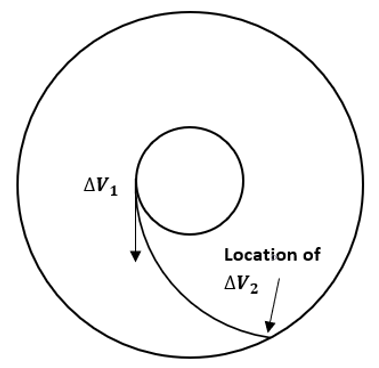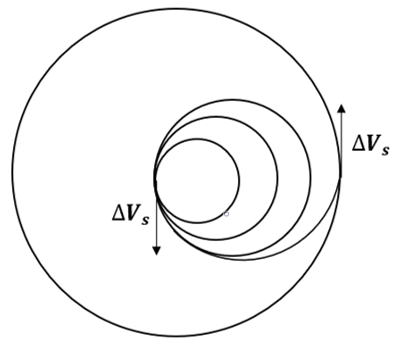This set of Orbital Mechanics Multiple Choice Questions & Answers (MCQs) focuses on “Phasing Maneuvers”.
1. Which of these impulses is carried out for the Phasing maneuver?
a) Two-Impulse Hohmann transfer
b) Three-impulse Bi-elliptical transfer
c) One-Impulse transfer
d) One-Tangent burn
View Answer
Explanation: Phasing maneuver is a used when a spacecraft in a given orbit is moved to a different location within the same orbit. This is carried out using two-impulse Hohmann transfer. The first burn is carried out in the original orbit to shrink or expand the orbit. On completing the orbit and returning to the original burn point, it performs second maneuver.
2. Which of these reasons is not used for carrying out the Phasing maneuver?
a) For the spacecraft to move with another spacecraft behind it
b) For the spacecraft to move ahead of another spacecraft
c) To adjust the inclination angle of the orbit
d) To save fuel
View Answer
Explanation: The phasing maneuver is usually carried out when the spacecraft needs to rendezvous ahead or behind another spacecraft. Also, sometimes this is carried out to save the fuel by entering a phasing orbit closer the original orbit and performing multiple orbits before returning back to the orbital burn point.
3. For military operations requiring high energy, which of the orbits is used?
a) Hohmann transfer
b) High energy orbit
c) Low-thrust chemical transfer
d) Electric propulsion transfer
View Answer
Explanation: For military operation mission, more energy is required than what is required for the Hohmann transfer. High energy orbit is used when transfer time is of the essence. In this operation, an impulse is given at the initial circular orbit which pushes the spacecraft into an elliptical orbit. After reaching the desired point, another small impulse is given to circularize the orbit and place the spacecraft at the desired altitude.

4. Low-Thrust chemical transfer makes use of consecutive burns at the apogee to reach final orbit.
a) True
b) False
View Answer
Explanation: The Low-Thrust chemical transfer executes sequential burns at the perigee then finally one burn at the apogee to reach the final higher orbit. In the figure, a small impulse is given at the initial circular orbit, thus raising its altitude. Following this there are multiple- burn maneuvers to keep raising the altitude sequentially after finally reaching the desired altitude.

5. Which of these transfers makes use of spiraling outward in order to reach the final orbit?
a) Hohmann transfer
b) High energy orbit
c) Low-thrust chemical transfer
d) Electric propulsion transfer
View Answer
Explanation: In case of electric propulsion transfer, the final orbit is reached by spiraling outward as there is less consumption of propellant due to the high Isp value of the electric propulsion.
6. If the interceptor has to catch a spacecraft ahead of it in the same orbit, what function will it perform?
a) Speed up
b) Speed down
c) Change its inclination
d) Change its true ascension
View Answer
Explanation: To catch a spacecraft ahead of it in the same orbit, the interceptor slows down, entering a smaller phasing orbit with a shorter period. This allows it to catch the target and go ahead of it.
7. If the target is ahead of the interceptor, what function will it perform to intercept it?
a) Speed up
b) Speed down
c) Change its inclination
d) Change its true anomaly
View Answer
Explanation: If the target is behind the interceptor in the same orbit, the interceptor must speed up to enter a higher, slower orbit thereby allowing the target to catch up.
8. What is the semi-major axis of the phasing orbit if its time period is 10,000 seconds?
a) 10,110.61 km
b) 10,417.30 km
c) 10,251.65 km
d) 10,032.12 km
View Answer
Explanation: The relation between the semi-major axis and the time period of the orbit is given by:
a = \(\Big(\frac{\sqrt{\mu}T}{2\pi}\Big)^{2/3}\) = \(\Big(\frac{\sqrt{398,600 × 10,000}}{2\pi}\Big)^{2/3}\) = 10,032.12 km
9. Docking maneuver involves phasing maneuver.
a) True
b) False
View Answer
Explanation: Docking is the process of two spacecrafts rendezvousing on the same orbit at different true anomalies. By performing phasing maneuver, the two spacecrafts can perform docking operation by either slowing down or speeding up by entering a phasing orbit.
10. Which of these formulas is used to calculate the total impulse of the spacecraft to position it from initial to the phasing orbit?
a) ΔV = v2 – v1
b) ΔV = v2 + v1
c) ΔV = v22 – v12
d) ΔV = v22 + v12
View Answer
Explanation: In order to calculate the total impulse which is required by the space shuttle/ satellite to change its position from initial orbit to phasing orbit, ΔV = v2 – v1 is used.
Where, v1 is the spacecraft’s velocity at point of intersection in original orbit
v2 is the spacecraft’s velocity at point of intersection in phasing orbit.
Sanfoundry Global Education & Learning Series – Orbital Mechanics.
To practice all areas of Orbital Mechanics, here is complete set of 1000+ Multiple Choice Questions and Answers.
If you find a mistake in question / option / answer, kindly take a screenshot and email to [email protected]
